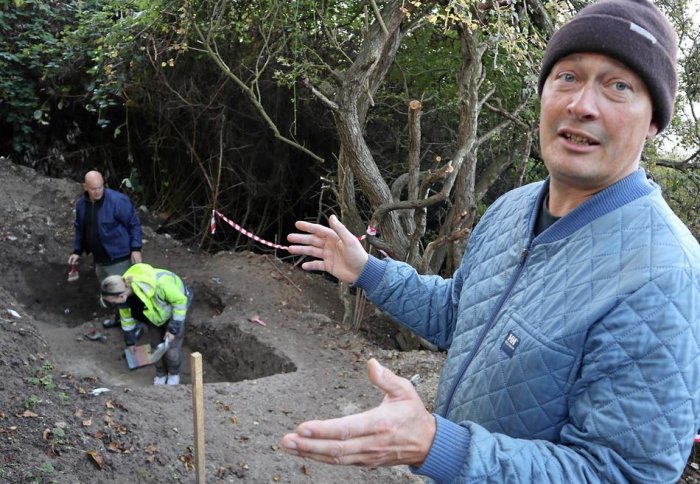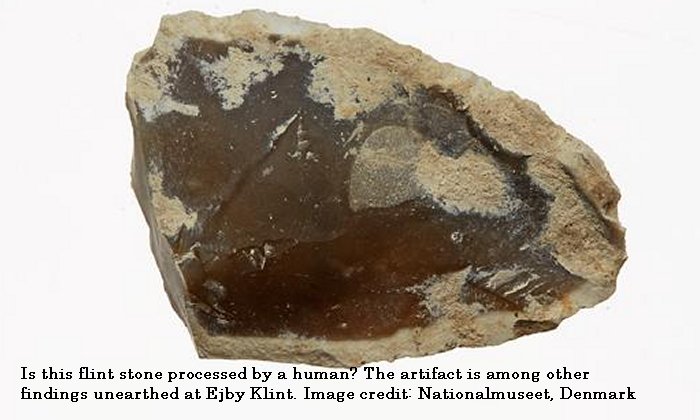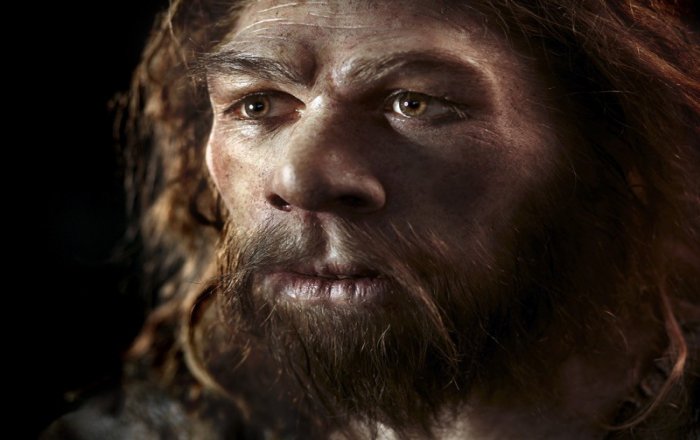Conny Waters – AncientPages.com – Some years ago, researchers had no evidence that Neanderthals lived in Scandinavia. There is enough evidence that Neanderthals were living in northern Germany and in the vicinity of the south of the modern-day Danish border.
The subject has been discussed for years, and some argue that Neanderthals never reached so far north because it was simply too cold. However, it is known that the southern Scandinavian climate was no harsher than other locations where it has already been established that Neanderthals lived.
 Ole Kastholm – archeologists at ROMU and the team that has been excavating the area for signs of human activity in Ejby Klint. Image credit: ROMU
Ole Kastholm – archeologists at ROMU and the team that has been excavating the area for signs of human activity in Ejby Klint. Image credit: ROMU
Extremely adaptable and flexible, Neanderthals survived for 200,000 to 300,000 years despite violent fluctuations in climate and their environment.
Looking from a climate point of view, Neanderthals could easily have lived in southern Scandinavia during an interglacial period.
Now, Danish archaeologists from Roskilde Museum and the National Museum have been looking for Neanderthals at Ejby Klint, and their hunt for Neanderthal traces from the time before the last ice age in this region of Scandinavia contributed with reliable evidence.
It is known that this layer of soil is precisely from the Middle Ages 120,000 years ago, so any finding of human remains in this particular place would mean a scientific breakthrough.
For the past six weeks, archaeologists have been digging in two places and examined a small part of Ejby Klint. The excavation has yielded 120,000-year-old mussel shells and flintstones that may have been processed by humans, and you can now see the most important of the finds in a display case at the National Museum.
Experts must now take a closer look at the stones and decide the big question: Have the forces of nature made the traces on the stones, or have they been in the hands of a Neanderthal?
“It’s absolutely wild and very unique that we’ve had the opportunity to dig here at all,” Lᴀsse Sørensen, head of research at the National Museum said, pointing out that the excavation itself is Danish history, and he is surprised that archaeologists have found so much.
“I did not think we would find anything at all, but we have actually found some stones that have possible traces of being humanly worked, and that in itself is amazing.”

“If we find out that these stones have been worked by Neanderthals, we write Danish history, and it will resonate all over the world. And even if they were not humanly worked, the excavation may open up for other investigations.”
Excavation leader Ole Kastholm from Roskilde Museum has never before dug such a challenging place, and he will now leave it up to experts to decide which stories the stones can reveal.
“Helping to dig on a steep cliff after the oldest people in Denmark right here around Roskilde has in itself been a huge experience. It must be up to the experts to decide how interesting what we have found is. But now the door may have been opened for more excavations to be made for Neanderthals in Denmark. “
It is absolutely crucial to search in layers that are certainly old enough. At the National Museum, there is already a molar from a forest elephant and a flint that has been carved with the same technique as the one used by the Neanderthals, but they have not been found in a layer of soil that can be dated accurately.
One of the few places in Denmark where archaeologists can relatively easily find layers in the earth that originate from the last two ice ages – is Ejby Klint. Additionally, they can also trace the warm period that occurred between the two ice ages for 115,000 – 130,000 years ago.
The history books state that the first Danes were reindeer hunters about 14,000 years ago. But well over 100,000 years earlier, Neanderthals lived in Germany, and it is not unlikely that the Neanderthals may have invented the area we know today as Denmark.
 The ancient Neanderthal man lived in Europe and parts of the Middle East and Asia 350,000 to 40,000 years ago. Perhaps the excavation at Ejby Klint can one day document that they also lived as far north as in present-day Denmark. PH๏τo: Creative Commons.
The ancient Neanderthal man lived in Europe and parts of the Middle East and Asia 350,000 to 40,000 years ago. Perhaps the excavation at Ejby Klint can one day document that they also lived as far north as in present-day Denmark. PH๏τo: Creative Commons.
During the warm period between the last two ice ages 115,000 to 130,000 years ago, it was four degrees warmer in Denmark than it is today, and in the country’s large hornbeam forests lived large prey such as beavers, steppe bison, fallow deer, wood rhinos, forest elephants, Irish giant deer and red deer. At the National Museum, you can see, among other things, a split deer bone from that time and the cheek tooth from a forest elephant.
The hunt for the earliest people in Denmark has often been led by amateur archaeologists, while professionals have looked skeptically.
In the 1960s, amateur archaeologist Erik Madsen picked up some of the flintstones below the cliff at Ejby Klint. The artifacts looked very old and decided to head into the cliff itself. There, he found three stones here which he thought might have been worked by a human hand. If Erik Madsen was right, it must have been a Neanderthal speaker who was behind it, but his theories were H๏τly debated, and today we only have the pictures left of the three stones.
The archaeologists from Roskilde Museum and the National Museum have dug in this particular place Erik Madsen visited a few decennia ago.
Head of Research at the National Museum Lᴀsse Sørensen hopes that Roskilde Museum and the National Museum’s excavation can help strengthen the interest in searching for Neanderthals in Denmark and open doors.
“Before the excavation, I had no hopes that we would ever find traces of the Neanderthals in Denmark. After the excavation, I am more optimistic, and I hope that we can participate in more excavations in the future.”
Sn.dk
Nationalmuseet
Written by Conny Waters – AncientPages.com Staff Writer





